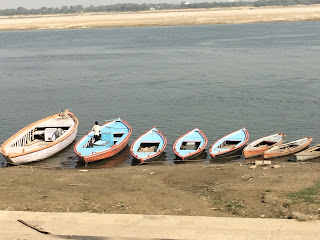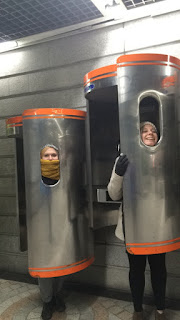India Part 2: India
I arrived in India at 3am. Jonathan and I were on the same flight, and we found Emma, Rasa, and Alicia at the airport before getting in our taxi to the hostel. The air outside was humid and mild, and the taxi driver had the windows cracked open. I stared at the open street outside and the huge trees that lined the edges. Lamp post rays cut through pollution haze and fog, and even though I knew the air quality was bad, it was kind of beautiful. My first impression of Delhi was a quiet one, but that would change in a few hours.
In New Delhi we stayed at a YWCA hostel, right in the middle of the city near Connaught Place. My first few days in India were definitely a mild honeymoon phase, and I was totally absorbed by everything we saw. Going from Korea in the wintertime to India is a significant change. Aesthetically, Korea (especially Iksan) is a pretty industrial and utilitarian place, and the buildings are gray and nondescript boxes with giant neon signs. The cars are almost all gray, silver, or white, and there are few trees inside urban areas. The color palate of Korean fashion is pretty muted and simple as well - lots of solids and stripes. Combine that with an orderly, collective-oriented culture, and shifting to the chaos of India is huge. The first thing I noticed was the obvious sunshine, warmth, and green space, and then the fact that things are happening everywhere. The traffic is constantly busy, people are going about their daily lives on the street and sidewalks, and animals are all over the place. The cars and auto-rickshaws are painted with bright designs, the clothing is bright, and the buildings (especially in Jaipur and Kolkata) have color. In the first couple days we passed a group of homeless that stay on the large sidewalk near the YWCA, people eating and chatting on street corners, someone getting a tattoo under a tree, and monkeys sorting through garbage to find food. While Indian society can be hierarchical and role-based, not unlike Korea in some ways, the constant public activity also breathed life into everywhere we visited.
That being said, not all of it was beautiful. There was a lot of visible poverty and a lot of trash, which I knew to expect. I had also been prepared (as much as one can be) for the roller-coaster like experience of riding through traffic and crossing busy streets, where honking serves more of an echolocation, "here I am" purpose than a warning. In some cases, the only way to cross was to walk in front of traffic and literally put one's hand on an oncoming car or bike in order to stop it. By the end, I was almost used to it.
Maybe because we were moving so fast and taking so much in, in the first few days I was surprised by how unaffected I felt by homeless that lived outside the YWCA, the constant beggars, and the obvious disparity of wealth in one city. We moved from Delhi to Jaipur, and one morning when we were crossing the street I felt something sharp hit my heel. I thought maybe I had bumped into something, until I felt it again, this time harder. I looked down and saw a plastic bottle attached to a stick, poking in and out of my bare ankles, as if trying to trip me. Turning around, there was a small boy behind me pushing the stick into the ground and staring straight ahead as he walked forward. He was with another young boy, and I pulled out some candy from my bag to offer to them. I was slightly annoyed actually since that stick hurt, but I figured it was a pretty unique strategy to get people to notice you.
We had been advised that we would encounter a lot of children begging on the streets (who will especially come up to foreigners), but money doesn't really help them because it often ends up in the hands of someone else. So instead, candy. Both boys took what I offered, but the one pushing the stick didn't look up - he seemed a little bit off, and when someone else in our group offered him gum, he didn't respond and kept staring at the stick, pushing it forward on the ground. There are a lot of reasons why he could have been acting this way, but Pawan gave one guess: the boy was drugged. According to Pawan, some street kids find ways to get high with synthetic materials, like spray painting pieces of bread before eating them. Because what else are they going to do? The helplessness their situation was visceral, and it made my stomach feel sick. Reality hurt a little harder that day.
In a lot of places we visited, the rich, the poor, and everything in between are right on top of each other, or at least nearby. Static poverty seems normalized. Of course, some still use creative ways to get by and maybe even create wealth, but there are just too many people for everyone to make it out. I would guess that a lot of people India either ignore the poverty and try not to think about it too much, or they engage in a kind of cognitive dissonance that makes it justified. The caste system helps accomplish this.
This cognitive dissonance isn't too far from the way many people in the United States think too, but one difference is that when poverty is more geographically separated, it's easier not to think about it. In India, the caste system (and perhaps not knowing how to change society) helps rationalize the visible wealth disparity, while in the United States, historical practices and divisions, such as redlining, help racialize it and tuck it away. I don't know enough about India to know how often castes get separated into different areas (although I'm guessing the wealthy don't hang around the slums too often) but it did seem like there was more mixing than in the States. In New Delhi, the large block where the homeless slept was right next to a pristine and famous Sikh Gurudwara (which is fitting, since the Gurudwara radically offers free meals where all castes eat together) and Hanuman Road, a collection of some of the wealthiest homes in Delhi. In Kolkata, Boyd picked up a disposable ceramic cup off of the street and showed it to us. These cups were originally created so the Brahmin don't have to drink chai from the same cups as the lower castes, and instead they can throw them away. The divisions are explicit and behavioral, but aside from retreating to a gated house, it's hard to make poverty invisible. Whereas in the U.S., wealth can exist in a bubble - just avoid the "sketchy" neighborhoods and it's like it's not really there.
I of course am not trying to say that magnitude or nature of problems in India and the U.S. are the same. But it does make you think.
Beyond contemplating all this, my time in India felt sort of like a new adventure every day. The group got along really well, and I didn't do much specific research before the trip so everything was a surprise. I was astounded by a lot of what we saw, which included many mountain and rooftop views. Between spending so much time with other Americans and doing the activities that Boyd planned, there wasn't a lot of room left to dwell on my life in Korea, and the trip was a true physical and mental separation from the rest of my grant year. We learned about religion, saw some palaces, walked through a desert to an ashram oasis, talked with friends, and ate a lot of really delicious vegetarian food. By the end of the trip, there were moments when the exhaustion and sheer overstimulation of the streets became too much, but for me at least, it was nothing that couldn't be fixed by a nap.
One of the moments that stood out to me the most, perhaps because Boyd told us it's his favorite, was when we took a sunrise boat ride on the Ganga (Ganges River). That morning, it was too early for me. I was cranky and the person who arranged the boat hadn't arrived on time, so while we were waiting, we found a guy near the water selling chai. At first, he charged me twice as much as he should have (so basically 60 cents instead 30), until he refilled my cup. And it was the best chai I had in India. Following that, we managed to get a boat, and as the sun was rising we lit small paper lanterns with wishes/prayers and floated them onto the river. It's really difficult to describe this area in any way besides incredible. There were huge clusters of birds scattered in front of the sun, we rowed past the burning ghats and a sunken temple, and then we had breakfast on a rooftop overlooking the river. Incidentally, this breakfast may have also given Jonathan salmonella. But I loved it anyway.
Saying goodbye to the group and to India was not easy, but I was lucky enough to spend my last day in Delhi visiting Sujoy, a friend from Oberlin who's been doing environmental development work in India for about a year now. I got to meet a lot of his friends/friends of friends in Delhi, and it gave me a totally new perspective from the two weeks with Boyd. As opposed to having someone present India to me and try to fit a lot learning in, I got a short view in what it's like for *some* people my age who are just living there. And for me, that was as valuable as everything else.
Thankfully, the transition back to my teaching life in Korea was not as harsh as I thought it would be, and this semester has been off to a really good start. India left a strong impression though, and hopefully it won't be the last one.
 |
| Ganga/Ganges River |
 |
| Paper lanterns on the Ganga |
 | ||
Watching the sunrise
|



Comments
Post a Comment